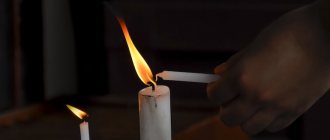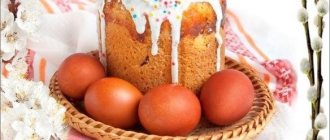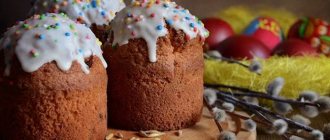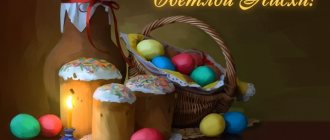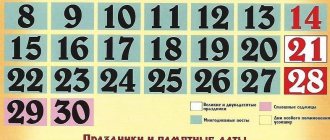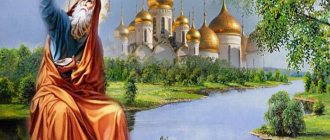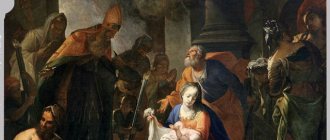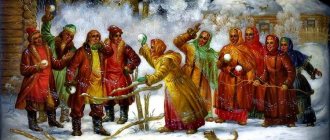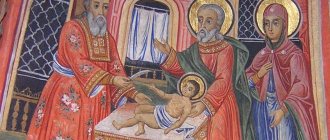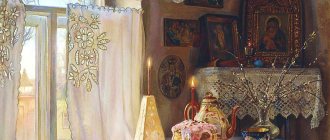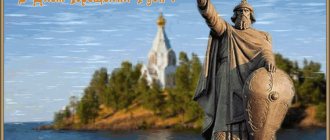Story
According to the four Gospels, the Resurrection of Jesus Christ occurred on the Jewish holiday of Passover. On this day, the Jews celebrated the exodus from Egypt. The Old Testament says that the last “Egyptian execution”, which finally persuaded Pharaoh to decide to release the Jews, was the killing of all the firstborn by an angel. The angel did not touch only those who slain the lamb and smeared its blood on their doors. Thus, the blood of the lamb saved people from death. In the New Testament, Christ played the role of the Lamb who saves people.
Title "Easter"
Gradually, the Hebrew word “Pesach” was transformed into the Russian “Easter”. And people began to use the abbreviated name of the holiday more often instead of the full name.
The first Christians believed that they were living at the end of time and expected the Second Coming every year. In memory of the sacrifice of Jesus, they began to celebrate the liturgy, remembering all the events - from the Last Supper to the Resurrection. Every Friday turned into a day of mourning, and Sunday into a day of joy. This bitterness and joy reached their climax on the day of Jewish Passover. This is how Easter was born in our modern understanding.
How many days is the Christian Easter celebrated?
Orthodox Easter is celebrated for 40 days.
Orthodox Easter is celebrated for 40 days - 38 days of Easter plus Bright Resurrection and the Day of the Ascension of the Lord.
During these 40 days, Orthodox Christians are ordered to greet each other with a joyful cry of “Christ is Risen!” and answer: “Truly he is risen!”, connected with a threefold kiss.
Easter in Rus'
The holiday came to our region along with Christianity. After Saint Prince Vladimir baptized Rus', Easter became the most important state event. Celebrations have since lasted for at least three days. Sometimes Russian princes, after successful campaigns or the birth of an heir, extended the celebration for a whole week.
Resurrection Day preceded Lent, which lasted at least forty days. Our ancestors used this period of time for spiritual cleansing. Pilgrimage to monasteries was very popular. Simple peasants set out on foot many kilometers to arrive at the monastery during Lent. There they confessed and celebrated Easter already cleansed.
Celebrations in modern times
At all times, right up to the end of the first quarter of the 20th century, Easter remained not only the main spring holiday, but also the most central event in the calendar. This was the case until the early twenties, when atheism became government policy. The authorities banned Easter liturgies, contrasting the Resurrection of Christ with its counterpart - Workers' Solidarity Day.
But already in the early nineties of the last century, all prohibitions were lifted and several red days in the spring again appeared on the calendar. As in the old days, Easter occupies a dominant place among all religious events. Even the head of state attends a service on this day in the Cathedral of Christ the Savior in Moscow.
How to bake a delicious Easter
Tender Easter
Ingredients:
- 0.5 kg. premium flour.
- 4 teaspoons dry yeast.
- 3 pieces of chicken eggs.
- 150 grams of butter.
- A little salt.
- 6 tablespoons of sugar.
- 100 grams of raisins.
- 150 ml. milk.
Cooking process:
- To make the raisins soft, you need to soak them overnight in warm water. In the morning, dry it and set it aside for now. Add sugar and yeast to warm milk and leave for a while to let the dough brew.
- Afterwards, when the dough begins to bubble into it, gradually add all the remaining ingredients and knead the dough. Don't forget to add raisins to the dough as well. Knead the dough well and then put it in a warm place for a couple of hours. After the time has elapsed, the dough must be kneaded again and then left for another half hour.
- In order for Easter to work as it should, you don’t need to fill the entire form with dough. 2/3 will be enough, and leave the rest with a reserve. Preheat the oven to 180 degrees and bake until Easter golden brown. Then reduce the temperature and continue baking for another 30 minutes.
Easter with almonds
A wonderful Easter without baking that will delight you with its delicate and pleasant taste.
Ingredients:
- 900 grams of fat cottage cheese.
- 0.5 grams of fat sour cream.
- 3 cups cream.
- 3 egg whites.
- 2 cups white sugar.
- 1 pack of vanilla.
- 2 cups ground almonds.
Cooking process:
To make this Easter, you need to put the pureed cottage cheese, sour cream, beaten egg whites, sugar, vanilla, ground almonds in a special form and put it in the refrigerator overnight.
Easter with cognac
A very tasty Easter, which will have a slight taste of cognac, which will add a special piquancy to such delicious pastries.
Ingredients:
- 1.5 kilograms of premium flour.
- 0.250 ml. milk (2.7%)
- 0.230 grams sour cream (25%)
- 0.250 grams butter (67%)
- 9 pieces of chicken eggs.
- 0.5 grams of sugar.
- 25 grams of vegetable oil.
- 25 grams of fresh yeast.
- 1 teaspoon salt.
- 1 tablespoon of strong cognac.
- 150 grams of raisins.
- 1 pack of lemon zest.
Don't miss: Beautiful happy birthday greetings to a man (prose, poetry, cards, pictures and photos)
Glaze:
- 2 egg whites.
- 0.200 grams of powdered sugar.
- 0.150 grams of multi-colored confectionery powder.
Cooking process:
- You need to add yeast, sugar and two tablespoons of flour to warm milk. Mix everything well so that the yeast dissolves in the water. Place the dough in a warm place until it starts to bubble.
- We take our eggs and rinse them well under water. Then separate the whites from the yolks and beat the whites with a mixer. Add half the sugar to them and continue whisking until the mass increases in volume and the sugar is completely dissolved. Pour the rest of the sugar into the yolks and beat them in the same way as the whites.
- Add sour cream, salt, beaten yolks and whites to the container with our dough, mix everything until smooth. Then add cognac, vanilla and a little lemon zest. Then add half the flour and knead our dough. In the process, add butter and sunflower oil, continuing to knead our dough. Then add raisins and mix everything well again.
- Afterwards, the dough is covered with a napkin or towel and placed in a warm place so that it rises and increases in size several times. This will take about two hours.
- To make the dough stick to your hands less, grease them with vegetable oil and separate small pieces from the dough and place them in baking molds. Do not fill the entire pan with dough, as the dough will rise in the oven and overflow. Optimal filling of the mold is 2/3. We leave our dough in the molds for 45 minutes, and then in an oven preheated over low heat, we begin to bake them.
- As soon as the molds are loaded into the oven, the temperature should be increased to 200 degrees. Baking Pasok requires 20 to 25 minutes. During the baking process, you should test the dough to see if it is done.
Glaze
- Beat 2 egg whites into a fluffy, light mass and mix them with powdered sugar. Mix everything well so that the powdered sugar dissolves well. Then add a tablespoon of lemon juice and mix our mixture again.
- Then we dip the top of our Pasoks into the prepared glaze and sprinkle with confectionery powder.
Chocolate Easter
Ingredients:
- 1 kilogram of fat cottage cheese.
- 0.200 grams butter (67%)
- 3 chicken eggs.
- 0.150 grams of sugar.
- 0.200 grams dark chocolate.
- 1 vanilla stick.
- 0.5 ml heavy cream.
- 0.100 grams of nuts.
- 0.200 grams of candied fruits.
Cooking process:
The cottage cheese needs to be squeezed out to remove excess moisture from it. Then grind it in a meat grinder.
Melt butter and mix with cottage cheese.
Remove seeds from the vanilla stick, but do not throw away the seeds themselves.
Mix sugar and eggs.
Put cream in them.
Throw the reserved seeds into the pan.
The mixture should be cooked for about 5 minutes, stirring constantly. The heat must be reduced to medium so that the mass does not burn.
The nuts need to be crushed into fine crumbs.
Melt dark chocolate in a water bath.
Mix the cottage cheese with the cooled mixture with eggs, cream and sugar.
Add melted chocolate and mix everything well.
Then put nuts and candied fruits in a bowl.
Place gauze in the Easter mold as shown in the photo. It needs to be folded in two layers and our chocolate mass placed in it.
Cover the mass with gauze and let the serum drain from it.
Place a weight on top and move our structure into the refrigerator for 13 hours.
Then turn the mold over and place the prepared Easter on a plate. On top it can be decorated with icing, or confectionery letters or sprinkles.
Folk customs and traditions
Since Christians abstain from fast food for a long time before Easter, many Easter traditions are of a culinary nature.
Kulich or Paska
The main dish of the holiday is butter cake, which is now commonly called “paska”. Easter cakes are baked in advance and illuminated in the church the day before the holiday. Our ancestors called paska a completely different dish - cheese baba. To prepare it, we used a lot of chicken eggs and selected cottage cheese. Easter cakes were baked separately. The paska had the shape of a pyramid, which symbolized Mount Golgotha, where Jesus Christ was buried. Eating Easter symbolized Christ's victory over death.
It is customary to carry Easter cakes to church in wicker baskets, made of wicker or other material. In some parishes, paskas are blessed in the evening before Easter, in others - already on Sunday.
A separate tradition is decorating baskets. Now many Western attributes have come to us, previously unusual for the Orthodox tradition. Such symbols include rabbits, yellow flowers and heart-shaped confectionery.
Painted eggs
Along with the Easter cakes, it is customary to put eggs in the basket, painted bright red or covered with an intricate pattern. They are also intended to symbolize the victory of life over death. There is a version that this tradition is dictated by the shape of the egg - there is life under the dead shell.
After the Easter meal begins, the children take the eggs in their hands and try to break their friend's egg. This game was called “Christification”, since when the egg was hit, the Easter greeting was usually pronounced: “Christ is Risen.”
Date of celebration of Orthodox Easter
In 2021, Easter will be celebrated on April 28. To understand how to correctly calculate the date of the holiday, you need to make some calculations. According to the Alexander Easter, according to which Easter is celebrated on the first Sunday after the spring full moon.
If the full moon occurs before the twenty-first of March (the vernal equinox), then the next full moon is considered Easter. And if the Easter full moon falls on a Sunday, then Easter is celebrated on the following Sunday.
Church service - Easter Liturgy
Worship in Orthodox churches begins in the evening of the previous day and continues throughout the night. Although most believers come only in the morning to get to the main part of the action - the Holy Liturgy. In ancient times, it was customary to baptize catechumens on this day. Then, in order to become a Christian, you had to prove your piety over a long period. Such candidates were called catechumens and were not allowed to be present in the church during the celebration of the sacraments.
During Lent, priests wear either passion vestments in red or mourning vestments in purple. In such clothes they begin the Easter service. But as soon as the joyful “Christ is Risen” sounds, they dress in the most beautiful outfits, made of white fabric with an abundance of gold.
Why do Christians celebrate Easter for 40 days?
Ascension of Jesus Christ
Christians celebrate Easter for 40 days in memory of the fact that this is how much time passed between the resurrection of Christ and his Ascension.
The celebration of Easter is divided into several main stages:
- Easter itself;
— Bright Week;
- Fomina week;
- the period from the beginning of the Week of the Myrrh-Bearing Women until the Ascension of the Lord.
Easter festivities
Immediately after the end of the festive liturgy, festivities begin. On this day, it is customary to wear your best clothes and not restrain yourself in showing joy. Young guys explode crackers and set off fireworks, large fairs open where not only goods are sold, but also various competitions are held. For example, a pillar is placed in the main square, with a valuable object tied to the top. To win the competition, you need to reach the top of the pillar and remove this item, receiving it as a prize.
From time immemorial, artisans have used folk festivals to show off their best products. For example, on this day bakers baked a gigantic Easter cake right on the square and divided it among everyone.
The Sunday of Christ was also considered an excellent occasion for charity. On this day, the imperial couple could visit a shelter for orphans or the poor. Poor people were received in the houses of rich people or food was taken out to them on the street.
In the evening, towards the end of the festivities, it is customary to light the Easter fire. A fairly large fire was laid out in the main square of the village and lit at nightfall. Now, for obvious reasons, this tradition has been forgotten. Although in some villages bonfires are lit, not in the main square, but near the church.
About the symbols of Easter
There are several such symbols, and they may differ in different countries, but the main ones are Easter cakes, eggs, a wreath, and fire.
Easter cakes are delicious holiday bread with raisins, candied fruits and other goodies. It symbolizes Jesus himself, his flesh.
Eggs are a symbol of fertility. They are painted and painted for Easter. To do this, you can use both ready-made dyes and natural ones - beet juice, turmeric, onion peels, spinach and others.
There is also a fun tradition of “Christing”, that is, beating eggs. Whose egg remains intact is the winner.
The wreath is a symbol of eternal life, since it is round, which means it has neither beginning nor end.
Fire is another symbol of life, without which it is hard to imagine life on earth, because it warms and helps prepare food.
Every year a miracle happens - on the eve of Easter in Jerusalem, the Holy Fire descends from heaven, which then spreads throughout the planet and lights millions of large and small candles. The Holy Fire does not burn - this is its wonderful property.
Other symbols of Easter include the cross, the color red, and the Easter bunny. Jesus was crucified on the cross, and the red cross symbolizes his blood, so not every child will understand the meaning of these symbols, and why remind children about death and suffering once again. A much closer symbol to them is the rabbit or hare. It came to us from Western Europe, where, in turn, it arose as a symbol of the Resurrection of the Lord, back in pagan times. Today, children know the funny story about the Easter Bunny, who brings chocolate eggs and eagerly looks for them on the holiday. Why don’t we adopt this wonderful tradition and please the kids on Easter?
Features of worship
On Holy Saturday, around eleven o'clock at night, the Midnight Office is served, during which the Shroud is brought into the altar. Closer to midnight, the religious procession begins. The clergy and parishioners light candles and begin to sing the troparion “Thy Resurrection of Christ the Savior,” the text of which compares us with the angels glorifying Christ’s Resurrection.
The singing begins at the altar, is picked up by the parishioners, the clergy leave the altar and begin the procession around the temple. The parishioners follow them, symbolizing the myrrh-bearers who came at night to the tomb of Christ. Stopping in front of the closed doors of the temple, symbolizing the sealed Tomb of Christ, everyone waits for the exclamation of the priest.
Exactly at midnight the priest gives a shout to start the service. Then he, like the angel on the tomb of Christ, announces Christ's resurrection. The Sunday troparion is sung first by the clergy, then three times by the parishioners. Then verses from the psalm are sung, alternating with the Sunday troparion.
The doors of the temple swing open, and everyone enters the temple, like the myrrh-bearing women entering an empty tomb. Easter Matins begins, sounding quickly and joyfully. The Easter service is celebrated much faster than the Lenten services.
The Easter canon is sung, the entire service is not read, but sung. The psalter is omitted; the six psalms, kathismas, and doxologies usual for Matins are missing. At each song of the canon the exclamation of the priest is heard: “Christ is Risen!” during censing. Some priests change colored vestments during each song of the canon.
After the canon, the luminary “Flesh Asleep” is sung, then the stichera of Easter. The word of St. is read. John Chrysostom. Matins ends, the Easter hours are sung, consisting of troparions and the hymn “Seeing the Resurrection of Christ.”
The Easter liturgy begins with the singing of the festive troparion with verses of the psalm. Then the peaceful litany, Easter antiphons. Instead of the Trisagion, “Elits” is sung. The Gospel of John (Chapter 1) is sometimes read in different languages. Instead of “It is worthy to eat,” the tribute to Easter is sung, “The angel is crying.” The entire service takes place with the royal doors open, symbolizing the open entrance to the Kingdom of Heaven. Instead of “We see the light,” “Let them be fulfilled,” the Easter troparion is sung. Sounds like Easter holiday.
After the end of the liturgy, all believers break their fast with the items of the Easter meal.
Christ's resurrection
The Pharisees and bishops, having violated the legal peace of Saturday and Easter, went to Pilate with an unusual request - to protect the dead man. But nothing surprised Pilate anymore; he allowed them to place a guard at the tomb in which Christ was.
But without even realizing it, they established indisputable evidence of Christ’s resurrection. There was a seal on the stone from the coffin, and there was a guard near it. No one could approach the tomb, no one could steal the Body of Christ, which the Pharisees feared. But, nevertheless, on the morning of the day after Easter, the Body of Christ was not in the cave .
Scientists who examined the Shroud of Turin, in which Christ was wrapped according to the funeral custom of the Jews, found drops of blood and a negative image on it. This suggests that the body was emitting radiation, that the body was no longer earthly, ordinary, human. Thanks to a certain flash, the image of the Body of Christ was displayed on the Shroud, and drops of blood appeared on the fabric earlier than the image.
A certain phenomenon occurred, after which the Body acquired a different composition and passed through the fabric. We know that It also passed through the heavy structure of the stone cave in which it was located, for after the resurrection the Body was not in the tomb. It consisted of a different substance, so Christ, who appeared to Mary Magdalene, forbade her to touch Him.
He could freely pass through locked doors (into the upper room where the apostles were) and disappear (as in front of Luke and Clepa at the meal). However, He could eat like a man (before the apostles after the resurrection) and allow His wounds to be touched (by Thomas).
